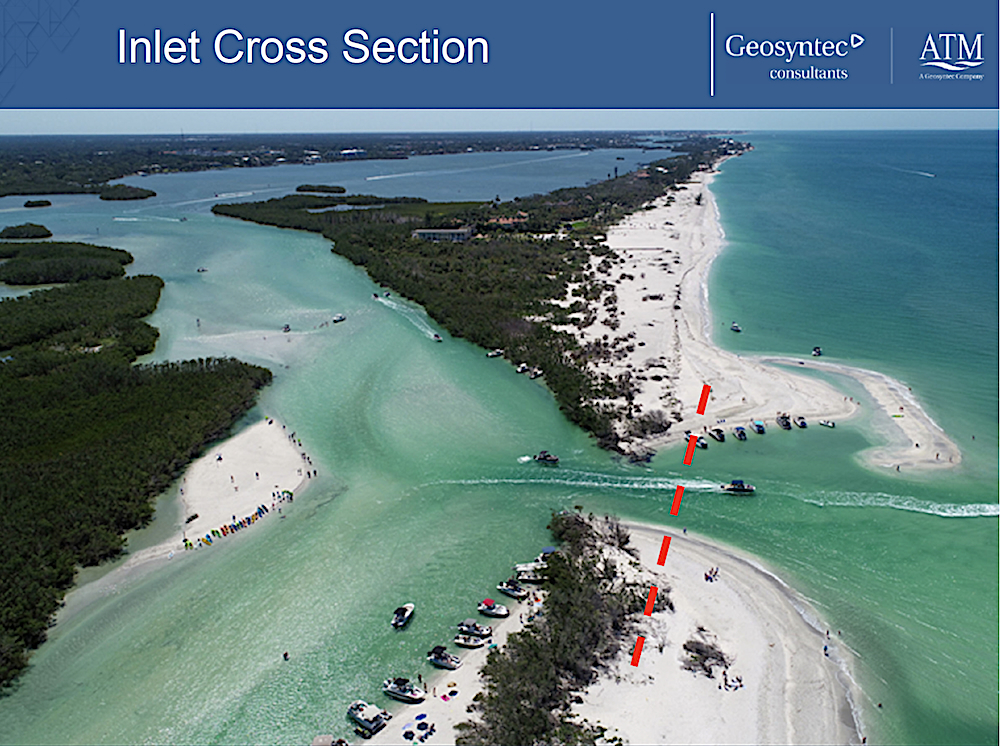Funding would cover a year’s work

In unanimously approving their Consent Agenda of routine business matters, as part of their regular meeting on Nov. 5, the Sarasota County commissioners authorized County Administrator Jonathan Lewis to submit to the West Coast Inland Navigation District (WCIND) an application for $500,000 for the monitoring and maintenance of Midnight Pass on south Siesta Key.
A document included in the Nov. 5 agenda packet notes that county staff estimated that Nov. 14 would mark the start of the WCIND initiative, with the period to end on Nov. 13, 2026.
Moreover, a county staff memo in the packet says the $500,000 would be used for the “implementation of an Emergency Response Plan if imminent natural closure of the pass is anticipated.”
The staff memo adds that the request for the funds would be scheduled for consideration during the “next available meeting of the WCIND Board …”
A Sarasota News Leader review of the WCIND board meeting schedule found that the next session is set for Nov. 14.
The money would come out of the County Navigation Improvement Fund (CNIF), which comprises reserves held by WCIND that are used, generally, for eligible projects; however, the WCIND board members can dedicate the money for initiatives at their discretion, as explained in the county staff memo.

The projected CNIF balance for Fiscal Year 2026, which began Oct. 1, is approximately $3,200,000, the memo says.
In late January, at the County Commission’s request, WCIND reclassified Midnight Pass and its associated north and south channels as public waterways, which made the waterway eligible for maintenance funding from the organization.
The county staff memo included in the Nov. 5 agenda packet explains, “A 1947 Special Act of the Florida Legislature created the WCIND to represent the local interests in securing resources, assets, and property necessary to construct the Gulf Intracoastal Waterway.” The memo adds, “Today, the WCIND’s mission is ‘[t]o preserve and enhance the commercial, recreational, and ecological values of waterways within the District we serve.’ Funding for the WCIND is secured through an ad valorem tax assessment upon each property in each member county.”
The WCIND is based in Venice.
In late September 2024, Hurricane Helene reopened Midnight Pass between the Gulf and Little Sarasota Bay. It had been closed since 1983.
Although the waterway soon closed again, when Hurricane Milton came ashore at Big Sarasota Pass, off the northern part of Siesta Key, on Oct. 9, 2024, its storm surge again established the waterway. Since then, Midnight Pass has remained open.
In September, an engineer working as a consultant to county staff provided details about the data accumulated about the pass since last fall, including changes in the inlet’s mouth. Midnight Pass appeared to be stabilizing, Mike Jenkins, senior principal engineer with ATM Geosyntec, told the county commissioners.

The depth of the “throat of the inlet” has ranged from 9.4 feet to more 17.7 feet, Jenkins said. “The trend is that it has gotten deeper, but it varies.”
He did point out that if it appeared Midnight Pass was closing, the county could issue an Emergency Declaration, under which “limited action could be taken,” but only through consultation with staff of the Florida Department of Environmental Protection (FDEP).
Three triggers would prompt such an Emergency Declaration, Jenkins noted:
- The reduction of the inlet throat to fewer than 500 square feet.
- The movement of the inlet’s center line beyond its present location — approximately 1,000 feet north or south.
- An imminent closure as a result of storm effects or a similar event.
